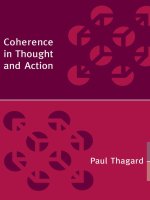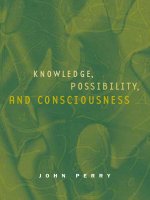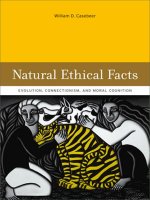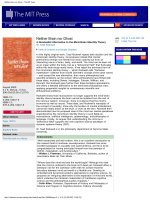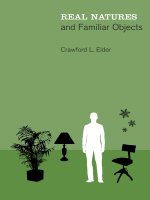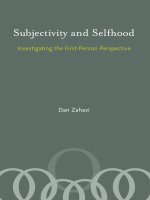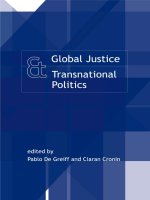the mit press real natures and familiar objects apr 2004
Bạn đang xem bản rút gọn của tài liệu. Xem và tải ngay bản đầy đủ của tài liệu tại đây (754.25 KB, 217 trang )
THE MIT PRESS
Massachusetts Institute of Technology
Cambridge, Massachusetts 02142
0-262-05075-7
,!7IA2G2-afahfd!:t;K;k;K;k
REAL NATURES
and Familiar Objects
Crawford L. Elder
In Real Natures and Familiar Objects Crawford Elder defends,
with qualifications, the ontology of common sense. He argues
that we exist—that no gloss is necessary for the statement
“human beings exist” to show that it is true of the world as it
really is—and that we are surrounded by many of the medium-
sized objects in which common sense believes. He argues further
that these familiar medium-sized objects not only exist, but have
essential properties, which we are often able to determine by
observation. The starting point of his argument is that ontology
should operate under empirical load—that is, it should give special
weight to the objects and properties that we treat as real in our
best predictions and explanations of what happens in the world.
Elder calls this presumption “mildly controversial” because it
entails that arguments are needed for certain widely assumed
positions such as “mereological universalism” (according to
which the sum of randomly assembled objects constitutes an
object in its own right).
Elder begins by defending realism about essentialness (arguing
that nature’s objects have essential properties whose status as
essential is mind-independent). He then defends this view of
familiar objects against causal exclusion arguments and worries
about vagueness. Finally, he argues that many of the objects in
which common sense believes really exist, including artifacts and
biological devices shaped by natural selection, and that we too
exist, as products of natural selection.
Crawford L. Elder is Head of the Philosophy Department and
Professor of Philosophy at the University of Connecticut.
“This book will be essential reading for philosophers who address questions concerning
the nature of folk objects, the basis for modal claims and our knowledge of such properties,
causation, vagueness, and much else.”
—WILLIAM R. CARTER, PROFESSOR OF PHILOSOPHY, NORTH CAROLINA STATE UNIVERSITY
“In his absorbing Real Natures and Familiar Objects, Crawford Elder advances the
metaphysical debate over the existence of commonsense objects and the objects, laws,
and properties posited by the special sciences. Elder writes clearly and nontechnically; his
approach is utterly sensible, and his conclusions will be embraced by philosophers and
nonphilosophers who feel the pull of a robust ‘realist’ picture of the world and our place in it.”
—JOHN HEIL, DAVIDSON COLLEGE AND MONASH UNIVERSITY
“Elder defends the much maligned ‘ordinary objects’ of common sense with rigor and
detail against such opponents as reductionists and soriteans. His closing description of
the ground floor of ontology would apply to the book itself
—
‘splendidly, marvelously rich.’”
—RICHARD GRANDY, DEPARTMENT OF PHILOSOPHY, RICE UNIVERSITY
REAL NATURES
and Familiar Objects
Crawford L. Elder
A BRADFORD BOOK
REAL NATURES
and Familiar Objects
ELDER
Real Natures.qxd 3/23/04 2:45 PM Page 1
Real Natures and
Familiar Objects
Familiar Objects
Crawford L. Elder
A Bradford Book
The MIT Press
Cambridge, Massachusetts
London, England
© 2004 Massachusetts Institute of Technology
All rights reserved. No part of this book may be reproduced in any form
by any electronic or mechanical means (including photocopying, record-
ing, or information storage and retrieval) without permission in writing
from the publisher.
This book was set in Palatino by SNP Best-set Typesetter Ltd., Hong Kong,
and was printed and bound in the United States of America.
Library of Congress Cataloging-in-Publication Data
Elder, Crawford.
Real natures and familiar objects / Crawford L. Elder.
p. cm.
“A Bradford book.”
Includes bibliographical references and index.
ISBN 0-262-05075-7 (hc: alk. paper)
1. Knowledge, Theory of. 2. Ontology. I. Title.
BD161.E43 2004
110—dc22
2003059684
10 9 8 7 6 5 4 3 2 1
To Carol, Brad, and Jared
Contents
Introduction ix
I The Epistemology and Ontology of Essential
Natures 1
1 Conventionalism: Epistemology Made Easy,
Ontology Made Paradoxical 3
2 The Epistemology of Real Natures 21
3Real Essential Natures, or Merely Real Kinds? 43
II Causal Exclusion and Compositional Vagueness 73
4Mental Causation versus Physical Causation:
Coincidences and Accidents 75
5 Causes in the Special Sciences and the Fallacy of
Composition 105
6APartial Response to Compositional Vagueness 119
III Toward a Robust Common-sense Ontology 129
7Artifacts and Other Copied Kinds 131
8Why Austerity in Ontology Does Not Work:
The Importance of Biological Causation 163
Notes 183
References 191
Index 199
viii Contents
Introduction
This book defends, with qualifications, the ontology of
common sense. It argues that we exist, in ontological strict-
ness—no paraphrase of the statement “human beings exist”
is needed to show it true of the world as it really is—and
that we are, in ontological strictness, surrounded by many
of the medium-sized objects which common sense believes
in, including some artifacts. Moreover this book argues
that our cognitive relation to our surroundings is much as
common sense supposes it to be. We often manage, that is,
to learn a great deal about familiar objects of this or that kind
just because our observations of individual members of that
kind catch sight of properties which members of that kind
have by nature—properties which any member is bound to
possess, so long as it exists at all. Familiar medium-sized
objects not only exist, then, but have essential properties, in
the traditional sense, and we often are able to determine
which properties are essential to one or another of nature’s
kinds. It is the latter claims that the book defends first, in
part I.
In the seventy-eight years since Moore’s “Defence of
Common Sense” (Moore 1925), familiar medium-sized
objects have largely disappeared from ontology, at least
among analytic philosophers. They have been crowded out
by sleeker rivals unheard of by common sense—objects
having crisper extinction conditions, or characterized by
properties not susceptible to sorites arguments, or objects
whose causal efficacy traces to far cleaner laws than would
ever fit common-sense objects. The approach of this book
will be to argue that these replacement objects have only the
weakest credentials as posits of an empirical understanding
of how the world works—or have impeccable credentials,
but only as posits of a badly incomplete understanding.
Thus the book will take for granted a general conviction that
ontology should operate under empirical load—that it
should give special weight to the objects and properties we
in fact treat as real in our best predictions and explanations
of what happens in the world, be it at the level of everyday
thought or of learned scientific theory.
This starting point is just mildly controversial. It entails
for example that there is a strong presumption against the
doctrine known as “unrestricted mereological composition”
or “mereological universalism.” This is the doctrine that the
mereological sum of any real objects, however seemingly
unrelated they may be, is an object in its own right. Thus,
on the assumption that the microparticles of physics are
genuine objects, the doctrine holds that there is an object
composed of seventeen microparticles in my left elbow,
forty-three microparticles at the bottom of the Marianas
Trench, one microparticle in the star Sirius, and the entirety
of the Navy’s latest Ohio-class submarine. Neither folk the-
ories nor learned theories about how the world works find
any need or use for such randomly assembled “objects”—
to put it mildly. So it follows, from my starting conviction,
that a heavy burden of proof lies on those who wish to argue
in favor of mereological universalism. This is mildly contro-
x Introduction
versial, since in many contemporary discussions it is
assumed that the burden of proof lies on those who oppose
that doctrine.
For all that, I think that my starting presumption will
seem only mildly controversial, at least in the general for-
mulation I have so far given it. For the ontologists who
recognize only the crisply defined objects unheard of to
common sense often see themselves as engaging in some-
thing much like scientific theory building. The real contro-
versy comes when one lists the specific topics on which, as
ontologists, we must attend to the tellings of experience, and
separates them from the topics on which we are free to settle
answers by stipulation. Is it, one might ask, open to the
ontologist to stipulate extinction and persistence conditions
for the objects his ontology affirms—to settle by definition
that such-and-such entities can survive these changes but
not those, or can be spatially deployed in certain ways but
not in others, and so on? The position this book will take is
that we must learn from nature where there are real neces-
sities, real continuings, and real unities. These matters are
not ours to fashion; they are fixed independently of us. This
is of course a frankly realist position, and controversially so.
No book should simply presume such a position, and this
book will not. Part I is an extended argument for this par-
ticular sharpening of the general stance, in itself fairly
uncontroversial, that ontology must operate under empiri-
cal load.
The role of part I, then, is to defend realism about essen-
tialness in general—the idea, that is, that it is the case mind-
independently that nature’s objects possess specific ones of
their properties essentially. But are the familiar objects which
common sense believes in among nature’s objects? Doubts
whether such objects really exist in the world have lately
Introduction xi
been motivated by worries about causal exclusion and
sorites paradoxes. Part II defends familiar objects against
causal exclusion arguments, and offers a partial response to
one species of sorites paradox.
Part III then takes up the task of defending positive claims
as to just which of the familiar posits of common sense really
exist. Chapter 7 argues that many of the artifacts in which
common sense believes really do exist, as do many biologi-
cal devices shaped by natural selection. Chapter 8 defends
the position that we exist, and are ourselves endowed with
many abilities shaped by natural selection—and thus that
our existence involves the existence as well of genes and
populations and language communities.
I am grateful to Nick Zangwill, Margaret Gilbert, and
Austen Clark for encouraging me to write this book. For dis-
cussions about the contents of the book, I am grateful to
Nick Zangwill (again), Nenad Misˇcˇevic´, Gene Mills, Mike
Rea, and Tom Bontly.
But my greatest debt, as will quickly become apparent, is
to my colleague Ruth Millikan. Twenty years ago I puzzled
my way through a deeply unorthodox and deeply illumi-
nating manuscript titled Language, Thought, and Other Bio-
logical Categories, then in press at MIT Press/Bradford Books.
I returned to the book a few years later to think more closely
about the last chapters, which deal with ontology. I have
been thinking about them ever since, and the present book
is the result. I must add that the actual, historical Ruth
Millikan does not agree with all that is in this book: she
questions whether modal discourse reports objective states
of affairs, and positively disagrees with the conclusions of
chapters 4 and 5. I console myself with the reflection that
she should agree with the positions of this book, and that she
once appeared to do so!
xii Introduction
I
The Epistemology and
Ontology of Essential
Natures
Conventionalism:
Epistemology Made
Easy, Ontology Made
Paradoxical
We manage, it seems, to learn much about the kinds and
stuffs and phenomena which surround us in nature.
Through attentive inspection of individual members of
a given kind (or individual samples of a given stuff, or
individual instances of a given phenomenon), we manage
to identify properties which all members of the kind are
bound to possess, so long as they exist at all. Among these
are often properties, or combinations of properties, which
members of no other kind can possess. But exactly how
do we manage to identify essential natures, distinctive of
nature’s various kinds, stuffs, and phenomena? From what
premises do we infer such conclusions? The only developed
answer to this question currently on offer leads to unsettling
conclusions about the ontological status of essential pro-
perties. Or to speak more precisely, it leads to unsettling
conclusions not about the properties themselves that we
determine to be essential to nature’s kinds, but about the
ontological status of their being essential, of their essential-
ness. In this chapter I will argue that these conclusions
are not just unsettling but unbelievable. In the next chapter
I will offer an alternative answer to the epistemological
question.
Just what evidence apprises us that chromium necessar-
ily has an atomic number of 24, that quartz crystals by
nature have their molecules arranged in a certain sort of
lattice, that lightning is essentially an electrical phenome-
non? Not just that inspected samples uniformly present the
property in question. For we manage to draw distinctions
between properties which samples of a stuff or members of
a kind uniformly possess, and properties which they possess
by their very nature. We determine that all samples of
chromium come originally from Zimbabwe or South Africa
or Siberia,
1
but do not judge that coming-from-Zimbabwe
(-or-South-Africa-or-Siberia) belongs to chromium’s very
nature—that the samples had to come from Zimbabwe or
South Africa or Siberia. We may learn that diamonds are all
marketed by a monopoly enterprise, but do not infer that
they are by nature marketed in this way; we distinguish
between their being marketed by a monopoly and their being
composed of carbon. To put it differently, we somehow learn
that counterfactuals beginning “If chromium had been
present in the United States, ” may have completions that
make them true and important from the standpoint of
geology or economics or politics, whereas counterfactuals
beginning “If chromium had had atomic number 79, ” are
empty and uninformative—true only vacuously. But how?
Kripke (1972) famously argued that we learn from expe-
rience that gold essentially has atomic number 79, water
necessarily has molecular structure H
2
O, and that (degree
of) heat is by nature (degree of) mean kinetic energy. These
properties are, as science informs us, explanatorily rich—
they explain other properties that gold and water have with
equal uniformity, or enable us to predict uniform connec-
tions between (degree of) heat and pressure. This encour-
ages the thought that explanatory richness is the extra
4 Chapter 1
premise. If samples of kind K uniformly bear property p, and
p is in this way explanatorily rich, perhaps it follows that p
is an essential property of kind K. But is it not also an essen-
tial property of gold that gold has a melting point of 1073°C,
or that gold resists corrosion by all acids and acidic com-
pounds except aqua regia? Perhaps explanatory richness is
not a necessary condition for a property’s being essential.
For that matter, it does explain a good deal about diamonds
that diamonds are marketed by a monopoly enterprise.
It explains why they are expensive, and perhaps thereby
explains why they are given as tokens of important occa-
sions or deep feelings, and so forth. “Explanatory richness”
of at least some sorts may not be sufficient—even when
added to uniform occurrence—to ensure essentialness.
1.1 Do We Know “Template” Truths about Essential
Natures?
So what is the extra premise that, when added to the
uniform occurrence of p among inspected members of K,
permits us to infer that p is an essential property of Ks? The
only answer to this question that is now widely defended is
that we combine the uniformity we empirically discover
among members of K with something we somehow know
about the kind of kind to which K belongs (McGinn 1981, pp.
157–158; Sidelle 1989; cf. Jackson 1998 on our knowledge of
C-extensions). Thus it is said that we know, concerning
chemical compounds such as water, that whatever the mol-
ecular structure that samples of that kind prove uniformly
to possess, it is a molecular structure that samples of
that kind essentially or necessarily possess.
2
It is said that we
know, concerning physical elements, that if samples of phys-
ical element K prove uniformly to have atomic number x,
Conventionalism 5
physical element K has atomic number x by nature. Thus do
we know that the only nonempty counterfactuals concern-
ing K must depict K as having—or at least must be consis-
tent with K’s having—just that atomic number. It might be
said we know, concerning the substances which the miner-
alogist studies, that whatever the molecular arrangement
that the mineralogist determines samples of such a sub-
stance uniformly to have, it is an arrangement that instances
of that substance are bound to have—as quartz is bound to
have a particular lattice arrangement.
But how do we manage to know these “template” truths
concerning the kinds of nature’s kinds? Do we learn them
from experience? The thought here would have to be that
we perform a metainduction. We first infer from induction
over samples of gold that gold has atomic number 79 essen-
tially; from induction over samples of chromium that
chromium has atomic number 24 essentially; and at length
do a metainduction over physical elements in general—
inferring that each of them is characterized essentially by
a particular atomic number. But this thought obviously
cannot be defended, at least not in just this form. For we
cannot on the present way of thinking even arrive at the
premise that gold is characterized essentially by atomic
number 79 unless we already know that conclusion to which
the metainduction is to lead—that physical elements select
an atomic number not just uniformly but by nature.
Then how might we be said to know of these template
truths? One answer might be that we exercise a direct
intellectual insight, not mediated by experience, into the
natures of the higher-order kinds—for example, “physical
elements,” “chemical compounds,” “mineral substances”—
into which nature’s specific kinds fall. But that answer
seems fanciful, of course.
6 Chapter 1
Or might we learn of such template truths by armchair
reflection on our own classificatory practices? Perhaps it is
just a convention of ours to individuate physical elements
by atomic number, chemical compounds by molecular com-
position, and mineral substances by (chemical composition
and) molecular arrangement (Sidelle 1989). Perhaps, that is,
it is our convention not to judge or say that the same chem-
ical kind is present in two envisioned scenarios—two actual
contexts, or two counterfactual contexts, or a mix—unless
the kind envisioned in both is envisioned as having a single
molecular composition. If we do have conventions of indi-
viduation such as this, it seems plausible that upon armchair
reflection we would sense that we have them. We would find
ourselves being drawn to deny that a look-alike of water,
envisioned from the armchair as existing in some scenario,
were the same chemical stuff as water as soon as we realized
we were envisioning this look-alike as having a molecular
composition other than H
2
O—for example, the molecular
composition abbreviated as “XYZ.”
1.2 Conventionalism, and Essentialness as Mind-
bestowed
But if this is how we arrive at our judgments that certain
properties characterize nature’s kinds not just uniformly but
essentially, conclusions follow that are at least disturbing.
Are these judgments truly warranted? The extra informa-
tion we are now pictured as adding, to the empirical finding
that (say) gold uniformly displays atomic number 79, is
that we will not call a physical element “gold again,” in
speaking of an envisioned counterfactual scenario, unless
we manage to envision that element as having the same
atomic number as we have empirically identified in actual
Conventionalism 7
samples of gold. Is this enough to warrant the conclusion
that a physical element cannot or could not be gold, unless
it had just that atomic number? Does the fact that we would
not call something “gold” warrant the conclusion that that
something could not be gold? Well, perhaps the conventions
governing what we will call “gold”—our conventions for
individuating, our practices of classification—are the way
they are for a reason. Perhaps they have somehow been
shaped by the way the world is. But to call something a
“convention” is to suggest that we had latitude in adopting
it—that we could have proceeded differently. Now it is
true that that suggestion is avoided if we speak instead of
our practices of classification. But still there is nothing in the
view we are examining that suggests that our practices are
shaped by empirical contact with the world—and hence
nothing, barring the answer scotched above as fanciful, that
suggests that they are shaped by the way the world is.
So if our judgments of essentialness are truly to be war-
ranted, on the view we are examining, our conventions for
calling something “the same kind again” must be seen, not
as evidence for its being the same kind again, but as consti-
tutive of its being the same kind again (Sidelle 1989, pp. 49,
65, 67). That members of a given kind must cling to certain
properties through thick and thin, in all actual phases of
their careers and in all counterfactual scenarios, must not be
something indicated or suggested by our conventions’ being
such as they are, but something that obtains in virtue of our
conventions’ being such as they are. The essentialness of
essential properties is essentialness relative to us, relative to
our conventions or practices. The essential status of essen-
tial properties is mind-dependent.
What is disturbing about this result is the way it intersects
with the thought that the essential properties of members of
8 Chapter 1
a given kind are properties which those members must
retain, so long as they exist at all. If the lattice arrange-
ment essential to quartz crystals is removed, then where
a moment ago there was a quartz crystal, there will be a
quartz crystal no longer—the quartz crystal will have been
destroyed. If the property of containing-79-protons-in-the-
nucleus disappears, where a moment ago there was a
gold atom, that gold atom will have ceased to exist. But in
virtue of what are these occurrences destructions—ceasings-
to-exist—instead of mere alterations in something that con-
tinues? This is the same question as: in virtue of what are
these essential properties of quartz crystals and gold atoms,
and not just properties that quartz crystals and gold atoms
have so far proven to have? And the answer on the present
view will be: in virtue of our conventions’ being such as they
are (Sidelle 1998, pp. 440–441). Independently of us, there
will be in the world only a play of properties, one property
giving place to another and that property to another in turn.
That some switches of properties amount to ceasings-to-
exist, that others amount to comings-into-existence, whereas
yet others amount to mere alterations, is the case only rela-
tive to us and our conventions. In other words, that the exis-
tences of the world’s objects begin where they do, and end
where they do, will not be independent of us and our con-
ventions. Beginnings and endings of existence, for the
world’s objects, will obtain only relative to us.
Should this result be articulated in antirealist fashion, as
the claim that we by our conventions actually construct
the existences of the world’s objects? Proponents of the con-
ventionalist account of essentialness in fact divide on this
question. Alan Sidelle, a prime exponent of conventional-
ism, provides an austere interpretation that avoids anti-
realism; many other exponents elect strongly antirealist
Conventionalism 9
formulations. My position is that either style of articulation
is disturbing in its own way—indeed, if the arguments of
the next section are right, conventionalism on either articu-
lation is simply not believable.
On Sidelle’s version of conventionalism, all that there is
in the world, independently of us, is “stuff” (or, as a com-
mentary on Sidelle calls it, “world-stuff”).
3
World-stuff is by
no means undifferentiated: it bears all manner of different
properties, and throughout it particular properties routinely
get replaced by other properties. But there are no objects
in the world as it is independently of us. For objects are
(or would be) entities that get destroyed when certain pro-
perties are replaced, and merely alter when certain other
properties get replaced—objects have certain properties
essentially, and others merely contingently (Sidelle 1998,
p. 441; 1989, p. 55n.). And there are, in the world as it exists
independently of us, no modally qualified states of affairs.
Apart from world-stuff—apart from the world as it exists
independently of us—there is only us. That is, there are our
conventions of individuation, and (presumably) the utter-
ances and thoughts that implement these conventions. Our
making these utterances and having these thoughts create
in us the impression that there are in the world objects,
having certain properties essentially, but this impression is
strictly false. It must be added that Sidelle’s writings are
tight-lipped about just what our existence involves—it may,
for all the texts show, amount to no more than the occur-
rence of a series of such utterances and thoughts.
Most philosophers of generally conventionalist sympa-
thies elect a richer picture of the world. There do exist in the
world objects, on the richer sort of picture, and the exis-
tences of the world’s objects have beginnings and endings.
But they have these only relative to our conventions for indi-
10 Chapter 1
viduation, our practices of classification. So it is in a sense
true that we (by our conventions) construct, shape, the exis-
tences of the world’s objects. This is of course “construction”
in a transposed sense. It does not require the use of hammers
and saws, and we do not do it in the sweat of our brows.
We do it merely by thinking and talking as we do. And if
this sounds mysterious—how, by just thinking, can we
make objects arise and last for determinate periods and then
cease to exist?—the answer is that the objects to which
we do this are as insubstantial as our own constructing
activities. They have only the shadow reality of a mental
(or a linguistic) projection. But being just that—having no
existence save existence-relative-to-our-thought-and-talk—
they really are entities whose existences we delimit just by
thinking and talking. There are in the world no “ready-made
objects” (Putnam 1982; cf. Putnam 1981, pp. 53–54). Rather
the world of objects is “a kind of play,” a series of stories, of
which we are the authors; we do ourselves appear in the
stories, but nevertheless “the authors in the stories are
the real authors” (Putnam 1977, p. 496).
1.3 How Conventionalism about Essentialness Yields
Paradoxes
Are these two alternative conventionalist pictures of the
world not just unsettling—or exciting, depending on one’s
point of view—but outright untenable? That is what I now
will argue. I will begin with a paradox that confronts at least
many, probably most, conventionalists who elect the antire-
alist picture. I will then present two parallel paradoxes, one
of which confronts the rest of the conventionalists who elect
the antirealist picture, the other of which confronts conven-
tionalists who elect the austere realist picture of Sidelle.
Conventionalism 11
Most philosophers nowadays subscribe to a materialist
view of our minds: human mental events are by nature
events befalling human brains. It is fair to infer that many,
and probably most, conventionalists are committed to this
general view. There are of course importantly different ver-
sions of materialism. Some hold that our mental events are
brain events neurochemically specified, others that they
are brain events functionally specified, yet others that they
are brain events teleofunctionally specified (Millikan 1984;
Elder 2001b). But all materialists—including all convention-
alists who are materialists—are committed to the position
that the existence in the world of human brains is logically
prior to the occurrence in the world of human mental
events. Human mental events are by nature events that
happen in or to human brains; unless and until there are
human brains in the world, there can occur no human
mental events.
Yet human brains seem par excellence to be entities that can
survive some alterations and cannot survive others; they
seem to have essential properties, properties they must
retain if they are to go on existing at all. Just what are those
essential properties—to what natural kind do human brains
belong? In chapter 7 I will present reasons for thinking
that human brains all by themselves amount to a particular
natural kind. But even there I will defend only general
remarks about the kinds of properties that characterize them
essentially. Specific answers on the properties essential to
human brains is a question for empirical science, I will
argue. Still it is safe to say that human brains must retain
certain properties of structure and organization if they are
to go on existing at all. A human brain cannot survive being
compressed to the size of a sugar cube; it will likewise be
destroyed if a bolt of lightning vaporizes it and disperses its
12 Chapter 1
